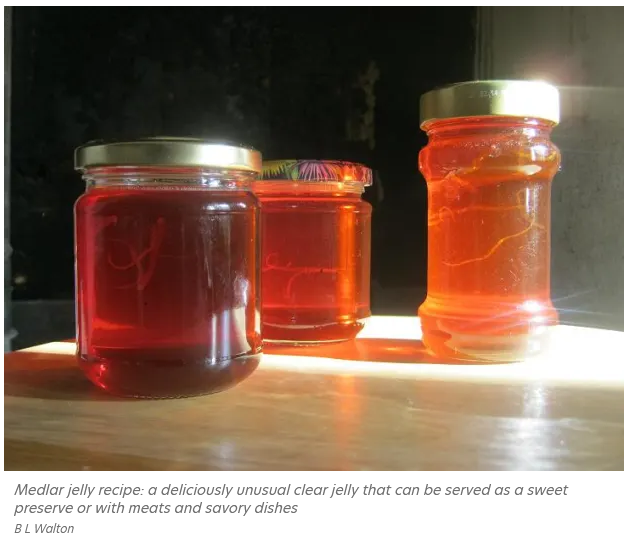
The Forgotten Medlar Fruit

Ever heard of a fruit called medlar? No? Don’t worry – most people haven’t! This peculiar fruit was all the rage in medieval Europe, but since then it has exited stage right. Between its vulgar nickname and its strange way of ripening, the medlar is basically the rockstar of forgotten fruit. But guess what? It’s making a small comeback – especially with home canners and jam makers who enjoy their produce having a little personality!
Let’s dive into the bizarre, yet delightful world of the medlar – and how you might be lucky enough to preserve it at home!
Imagine living during Shakespeare’s time and imagine the kind of food they had access to consume. It wasn’t plentiful, that’s for sure. Especially during winter months, when most fruit was not readily available. Due to our modern technology and booming society, we can obtain any fruits or vegetables we want just by simply going to a grocery store (and even having it delivered to our front door these days!)
Now imagine living during Shakespeare’s time and you look out into the backyard and see a rose bush taking full bloom. Not so strange, right? What if it took bloom in December? In the middle of winter?! Okay, I know. I sound crazy but hear me out. This is what the medlar fruit did! It grew from a rose bush in DECEMBER!

Medlar is a rare fruit nowadays, but it was about as popular as an apple during its time. Medlar, quite literally, means “open-arse” (and yes, we’re laughing with you!) The ancient Greeks wrote about it, Romans loved it, even Charlemagne made it a mandatory staple in royal gardens. It shows up in the works of Chaucer, Shakespeare, and even in Renaissance art! This fruit has seen it all. Except our modern kitchens, that is.
Despite its roaring popularity, the medlar quietly fell from the spotlight in the mid-20th century. This is due to some really strange things that don’t resemble fruit of today. Medlar looks odd, but the kicker is…you can’t eat it right off the tree. This fruit has to ROT before it’s ready to eat.
You heard me. You have to wait for this fruit to sit around for weeks while it decays (a process known as bletting) and I know, it sounds gross! After the bletting process, medlar becomes sweet, tangy, and PERFECT for…any guesses?...anyone?...That’s right! CANNING!
Once medlar has gone through the bletting process, you can expect the flavor to be something like spiced applesauce, dates, and lemon curd mixed together, with a slightly grainy texture. Medlar then becomes ideal for jelly, butter, chutney, and brandy (where can we get some?! CHEERS!)

If you’re lucky enough to get your hands on medlar (farmers markets, specialty orchard, but especially online), then you need to know how to preserve it.
-
Blet the fruit – Let it sit in a cool, dry place for about 2-3 weeks, until it softens and turns brown.
-
Perform an operation – cut open the fruit, scoop out the insides and discard of seeds and skin.
-
Do your magic – Turn it into jelly, jam, or butter and can it up! Make sure to add lemon juice and sugar to jelly, and you can add cinnamon, nutmeg, and clove for a cozy fall treat!
-
Safety is the key – Can it safely using a water bath canning procedure. The medlar has enough acidity when combined with lemon or another fruit, but definitely use a trusted recipe (see below!)
Medlar may have left radar during the mid-20th century, but thanks to curious gardeners, foodies, and historians, this ugly fruit is making a small comeback. There are very few places you can buy this winterized fruit, but once you have it, many say you’re in for a treat! You can even order seeds and grow your own medlar rose bushes!
After you’ve grown your own medlar, make sure you purchase some Harvest Guard Reusable Canning Lids (that’s the only reason we’re all here, duh) and can it up. BUT…make sure you share pictures of your medlar journey and any recipe you use! Happy rotting!!!
Recipe for Medlar Jelly
Yield: Approx. 4 half-pint (8 oz) jars
Prep Time: 2-3 weeks (bletting)
Cook Time: 1 hour
Processing Time: 10 minutes (water bath)
Ingredients:
4 lbs ripe (bletted) medlars
2 cups water
1-2 tablespoons lemon juice (for acidity and brightness)
3 cups granulated sugar
Instructions:
-
Buy Harvest Guard Reusable Canning Lids (www.canninglids.com)
-
Allow freshly picked medlars to blet for 2-3 weeks (in a cool, dark place) until they are soft and brown.
-
Rinse gently, cut in half. Do not peel or core.
-
Place medlars in a large saucepan of water. Bring to a boil, then simmer, uncovered, for 45-60 minutes, mashing occasionally.
-
Pour the mixture into a jelly bag or cheesecloth-lined colander. Let drain overnight. Do not squeeze (clouds the jelly).
-
Measure the juice. You should get about 3 cups. Add lemon juice.
-
Pour juice into a large pot. Add an equal amount of sugar (1 cup sugar per 1 cup juice). Stir to dissolve.
-
Bring to a boil and cook rapidly until it reaches gel stage (220°F/104°C).
-
Skim off any foam.
-
Ladle hot jelly into sterilized jars, leaving ¼” headspace (or 1” since you’ll be using Harvest Guard Lids!). Wipe rims, apply Harvest Guard Lids, and secure the rings.
-
Process in water bath canner for 10 minutes (adjust for altitude, if needed).
-
Don’t forget to tighten your metal screw bands upon removing them from the canner (only if you’re using Harvest Guard Lids!)
-
Share pictures with us and then tell all your friends to buy Harvest Guard (hey, don’t fault me for marketing! 😊)
NOTE: When done correctly, medlar jelly will be a gorgeous amber-rose color!
SOURCES:
-
https://www.bbc.com/future/article/20210325-the-strange-medieval-fruit-the-world-forgot
-
https://www.theguardian.com/lifeandstyle/2010/nov/27/alys-fowler-medlars

